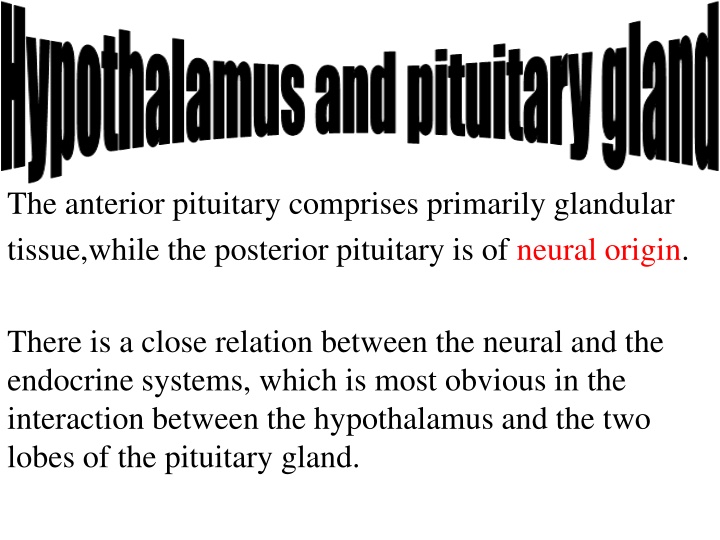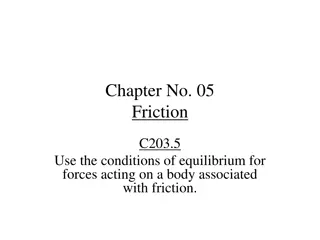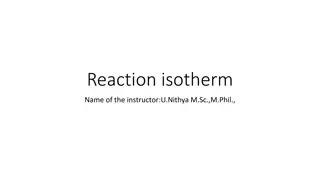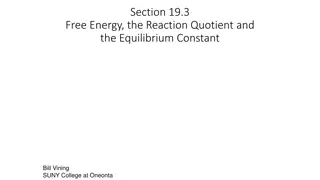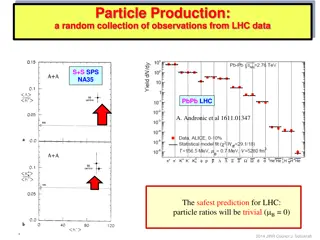Static Equilibrium in Physics
The concept of static equilibrium in physics through examples of objects at rest and in motion. Learn about the requirements and equations for equilibrium, and how to apply these principles to solve problems involving forces and torques. Understand the balance of linear and angular momenta in static systems.
Download Presentation

Please find below an Image/Link to download the presentation.
The content on the website is provided AS IS for your information and personal use only. It may not be sold, licensed, or shared on other websites without obtaining consent from the author.If you encounter any issues during the download, it is possible that the publisher has removed the file from their server.
You are allowed to download the files provided on this website for personal or commercial use, subject to the condition that they are used lawfully. All files are the property of their respective owners.
The content on the website is provided AS IS for your information and personal use only. It may not be sold, licensed, or shared on other websites without obtaining consent from the author.
E N D
Presentation Transcript
The anterior pituitary comprises primarily glandular tissue,while the posterior pituitary is of neural origin. There is a close relation between the neural and the endocrine systems, which is most obvious in the interaction between the hypothalamus and the two lobes of the pituitary gland.
The hypothalamus and the posterior pituitary lobe Antidiuretic hormone (ADH)(Arginine Vasopressin (AVP) Vasopressin is a nine amino acid peptide, it is synthesized primarily in the hypothalamus, controls the reabsorption of molecules in the tubules of the kidneys by affecting the tissue's permeability. It also increases peripheral vascular resistance, which in turn increases arterial blood pressure. It plays a key role in homeostasis, by the regulation of water, glucose, and salts in the blood. It is derived from a preprohormone precursor.
Vasopressin is responsible for increasing water absorption in the collecting ducts of the kidney nephron. The major stimulation of ADH secretion are:Hyperosmolality ans decrease ECF volume. The physiological ADH release occur with plasma osmolality in a narrow range (284-295 mOsm/kg) Thus when plasma osmolality. > ADH secretion > ADH secretion > ADH secretion > ADH secretion < 280 mOsm/kg When > 290 mOsm/kg And when ECF volume When ECF volume Thirst will stimulate ADH secretion. The half life of ADH is 10-20 min.
Kidney: Vasopressin has two effects by which it contributes to increased urine 1.) Increasing the water permeability of distal tubule and collecting duct cells in the kidney,. Cyclic-AMP activates protein kinase A(PKA) by binding to its regulatory subunits and allowing them to detach from the catalytic subunits. 2.) Increasing permeability of the inner medullary portion of the collecting duct to urea by regulating the cell surface expression of urea transporterst. Cardiovascular system Vasopressin increases peripheral vascular resistance (vasoconstriction) and thus increases arterial blood pressure.
Control of Antidiuretic Hormone Secretion
Oxytocin Is a nine amino acid peptide that is synthesized in the hypothalamus, but it differs from ADH in two of the nine amino acids.
Control of Oxytocin Secretion
Hormone of Middle Lobe of Pituitary The hormones secreted by intermediate lobe or middle lobe of pituitary gland are called melanocyte-stimulating hormones or MSH . Two forms of MSH -MSH and -MSH , the - is a single chain (13 amino acids) while is a polypeptide of 22 amino acids. The secretion is inhibited by Corticosteroids and its activity is inhibited by Catecholamines. Functions: MSH darkens the skin and is involved in skin pigmentation by deposition of mammalian by melanocytes. Abnormality: Addison s disease: MSH is in excess, which increases the synthesis of melanin resulting in brown pigmentation of the skin.
The hypothalamus and the Anterior pituitary lobe. The cells of the anterior pituitary lobe can be classified by their staining reactions as Acidophils : Somatotrophs which secrete growth hormone GH: somatotrophin. Lactotrophs which secrete prolactin. Basophils: secrete H. that affects other endocrine glands. There are three cell types:- A) Thyrotrophs: - secrete thyroid-stimulating hormone (TSH), (Thyrotrophin ) , B) Gonadotrophs: secrete gonadotrophins, follicle- stimulating hormone (FSH) and Luteinizing hormone (LH), which act on the gonads. C) Corticotrophs: it is a precursor of both adrenocorticotrophic hormones ACTH; corticotrophin and lipotrophin -LPH - -LPH: - is secreted inactive until rapidly converted to endorphins which is neurotransmitters Chromophobes: they are inactive, do contain secretory granules, often secrete hormones, particulary prolactin. .1 .2 (A (B .1
Pituitary Tropic Hormones Anterior pituitary gland secreted some tropic hormones usually called as pituitary tropins. A tropic hormone is the one which influences the activities of other endocrine glandThe tropic hormones produced by anterior pituitary are : Thyroid stimulating hormone(TSH or thyrotropin) . Adrenocorticotropic(ACTH or corticotrophin) . Lactogenic hormone (LTR or prolactin or luteotropin) . .4 Gonadal hormones:- Follicle stimulating hormone(FSH) Luteinizing hormone (LH) . .1 .2 .3
Growth Hormone Growth hormone (GH), also known as somatotropin, is a peptide hormone that is synthesized and secreted by the somatotrophs of the anterior pituitary gland. The main action of GH is to stimulate linear growth in children; however, it also fosters a healthy body composition by increasing muscle and reducing fat mass, maintains normal blood glucose levels, and promotes a favorable lipid profile.
Stimulators of HGH secretion (1-)Peptide hormones Growth hormone-releasing hormone (GHRH) Ghrelin through binding to growth hormone (2-)Sex hormones Increased androgen secretion during puberty (in males from testis and in females from adrenal cortex) Estrogen. (3-)Hypoglycemia, arginine. (4-)Deep sleep. (5-) Niacin as nicotinic acid. ( 6- )Fasting, and (7-)Vigorous exercise. Inhibitors of GH secretion include: (1)Somatostatin (2) Circulating concentrations of GH and IGF-1 (3)Hyperglycemia. (4)Glucocorticoids. (5)Dihydrotestosterone. o o o o o
two distinct types of effects: Direct effects are the result of growth hormone binding its receptor on target cells. Indirect effects: are mediated primarily by insulin-like growth factor-I (IGF-I
Control of Growth Hormone Secretion Production of growth hormone is modulated by many factors, including stress, exercise, nutrition, sleep and growth hormone itself. Growth hormone-releasing hormone (GHRH). Somatostatin (SS) Ghrelin is a peptide hormone secreted from the stomach. Ghrelin binds to receptors on somatotrophs and potently stimulates secretion of growth hormone.
Abnormalities of GH During childhood: Excess GH cause gigantism During adults: Excess cause acromegaly Gigantism :- Is caused by excess GH secretion in childhood before fusion of the epiphyseal plates. Acromegaly:- Results from GH excess in adults after epiphseal fusion. Cause increase in bulk of bone and soft tissues with changes in facial appearance. .3 Enlargement of thyroid gland. .4 Excessive hair growth .5 Menstrual disturbances. Impaired glucose tolerance diabetes mellitus. Increased plasma prolactin concentration. .1 .1 .2 .6 .7
Deficiency of GH: GH deficiency is one of the many causes of short stature and dwarfism. It results primarily from damage to the hypothalamus or to the pituitary gland during (congenital GH deficiency) or following birth (acquired GH deficiency). GH deficiency may also be caused by mutations in genes that regulate its fetal development synthesis and secretion. In adult rarely causes clinical symptoms. In children leads to dwarfism (short stature) the birth weight may be normal but the rate of growth is .1 .2 subnormal.
GH as Blood test GH testing is not recommended for general screening. It is primarily ordered on those with symptoms of growth hormone abnormalities, as a follow-up to other abnormal hormone test results, or to help evaluate pituitary function. Growth hormone tests are used to help identify excess or diminished GH production and give the doctor information about the severity of a person's condition. GH can be measured to assess the success of therapy for acromegaly or gigantism.
Different tests are used to diagnose growth problems: Growth hormone stimulation test. IGF-1 levels. Oral glucose tolerance suppression (to help diagnose too much growth hormone). An IGF-1 (Insulin-like growth factor 1) test is often ordered along with GH. IGF-1 mirrors GH excesses and deficiencies, but its level is stable throughout the day, making it a useful indicator of average GH levels. Testing to diagnose GH abnormalities often involves either a GH stimulation test or a GH suppression test. These are used to evaluate pituitary response and changes in GH levels.
When is it ordered? 1-GH stimulation testing is ordered when a child has symptoms of growth hormone deficiency (GHD), such as: 2-A growth rate that slows down in early childhood and the child is significantly shorter than others of the same age; 3-Thyroid testing (e.g., free T4) shows that the child is not hypothyroid (low thyroid levels can also cause slowed growth); 4-X-rays show delayed bone development; 5-A doctor suspects that a child's pituitary gland is under- active. GH and IGF-1 testing may be ordered at regular intervals for many years to monitor for recurrence of GH abnormalities in cases of GH excess.
1-Prolactin is synthesized as a prohormone . Following cleavage of the signal peptide , the length of the mature hormone is between 194 and 199 amino acids and stabilized by three intramolecular disulfide 2-It is secreted by the pituitary acidophilic cells 3-Its secretion and inhibition is under the influenced of (Neural stimuli). 4-Thyrotropin releasing H (TTRH) is a prolactin relasing factor (PRF). 5-Release of PRL is episodic and varies predictably during the day with lowest levels at midday and highest values shortly after the onset of deep sleep thus the best time for blood collection is between 8:00 10:00 a.m.
6-Increased in PRL levels in: 1-After stress of gyhecological examination 2-Stress of blood collection, nipple manipulation. 3-During sleep 4-During pregnancy 5-During lactation. 7-Pathological increase in PRL:- 1- Amenorrhea (cessation of menses) 2- Galactorrhea (breast discharge) 3- Female infertility.
